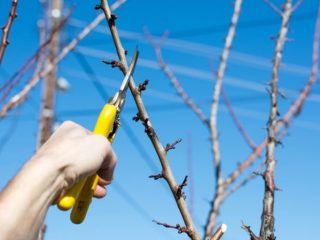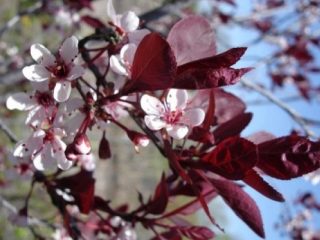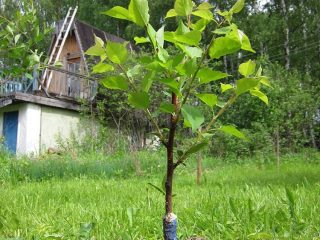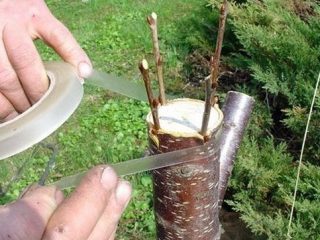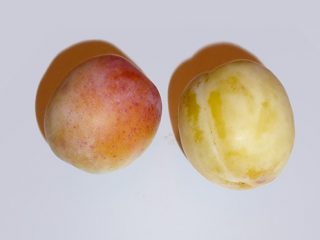Content
Yakhontovaya plum is a domestically selected variety intended for the middle zone. It is valued for its high quality fruit, reliability and unpretentiousness. Proper planting and care of the Yakhontovaya plum are the main conditions for obtaining a high yield.
History of variety selection
The Yakhontovaya plum was bred at the Moscow VSTISP. Breeders Kh. K. Enikeeva and S. N. Satarova worked on it. Parent varieties are Smolinka and Eurasia 21. The hybrid received its name due to the bright yellow color of the fruit. In 2008, the Yakhontovaya plum was included in the state register.
Description of plum Yakhontovaya
This variety of plum is a vigorous tree. The crown is compact, spherical; foliage is average. The height of the Yakhontovaya plum reaches 5 m.
The branches are bare, straight, brown. The leaves are elongated, long, with a pointed tip, light green in color.The surface of the leaves is matte and smooth, with small teeth along the edges.
Characteristics of plum fruits of the Yakhontovaya variety:
- yellow;
- thin skin;
- round shape;
- waxy coating;
- weight – 30 g;
- yellow juicy pulp;
- small bone, easily separated;
- sweet and sour taste, rated 5 points.
The Yakhontovaya variety is recommended for planting in the Central region. Due to its high winter hardiness, cultivation in colder climates is allowed.
Characteristics of the variety
Yakhontovaya plum has a number of characteristics that distinguish it from other varieties: winter hardiness, productivity, convenient timing of flowering and fruiting.
Drought resistance, frost resistance
Drought resistance is rated as average. For plums, both a lack of moisture and its excess are detrimental. The irrigation scheme is chosen taking into account weather conditions.
Frost resistance of plums is high. In order for the tree to easily survive the winter, additional shelter is provided in the fall.
Pollinators of plum Yakhontovaya
The Yakhontovaya plum is partially self-fertile. For a better harvest, you need to plant several varieties of plums that bloom at the same time.
Best pollinators:
- Hungarian;
- Red early ripening;
- Memory of Timiryazev.
Productivity and fruiting
The Yakhontovaya variety tree bears an average of 20–30 kg of fruit, and in good years – up to 50 kg. Fruiting is regular from year to year.
Area of application of berries
Plums are consumed fresh or used for homemade preparations. It makes delicious preserves, jam, compote, and sauce.
Resistance to diseases and pests
The Yakhontovaya variety is little susceptible to fungal diseases and pests.To protect the garden, it is recommended to periodically spray the trees.
Advantages and disadvantages of the variety
Before planting, evaluate the advantages and disadvantages of the Yakhontovaya plum.
Main advantages of the variety:
- abundant fruiting;
- good taste and appearance of the fruit;
- resistance to frost and disease.
Disadvantages of Yakhontovaya plum:
- impressive dimensions of the tree;
- partial self-fertility.
Is it worth buying a Yakhontova plum?
Yellow plum Yakhontovaya is an excellent option for planting in the Moscow region and other regions of the middle zone. Among its undoubted advantages are high quality fruits and productivity.
Landing Features
Its further growth and fruiting depend on proper planting of plums. Preliminarily assess the composition and moisture content of the soil on the site.
Recommended timing
The time for planting the Yakhontovaya plum is chosen taking into account the climate in the region. If there is a risk of early autumn frosts, then the work is left until the spring. Plums are planted when the soil has warmed up, but the leaves have not yet blossomed. In the southern regions, planting is carried out in the fall, when the trees have shed their leaves.
Choosing a suitable location
The place for growing Yakhontovaya plum is chosen taking into account a number of factors:
- constant lighting;
- south or west side of the site;
- light drained soil;
- no moisture stagnation in the soil.
The culture prefers drained fertile soils. The tree should not be located in lowlands where moisture accumulates. A flat area or an area with a slight slope is best suited for plums.
What crops can and cannot be planted nearby?
Plums are planted in groups, 2-3 different varieties. A distance of 3 m is maintained between trees.The culture does not take root well if pears, cherries and cherries grow nearby. Neighborhood with apple trees, raspberries and currants is allowed.
Selection and preparation of planting material
For planting, choose annual seedlings of the Yakhontovaya variety, about 50 cm high and shoots 2.5 mm thick. They can be purchased from a nursery or garden center.
Landing algorithm
Work begins with preparing a hole, which is filled with earth and left to shrink. The aging period is 1–2 months. When planting in spring, the pit is dug in the fall. If you plant a plant immediately, then after the soil settles, the seedling will be damaged.
The procedure for planting homemade plum Yakhontovaya:
- First, make a hole measuring 0.6x0.6 m to a depth of 0.7 m.
- Fertile soil is mixed with humus, 190 g of superphosphate and 80 g of potassium salt are added.
- The earth is poured into the hole.
- When the soil settles, they begin to prepare the seedling. Add soil to the hole and place a plum on top.
- The roots of the tree are straightened and covered with fertile soil.
- The soil is compacted and the seedling is moistened with warm water.
Aftercare for plums
Caring for the Yakhontovaya plum comes down to watering, fertilizing and pruning. Preparing for winter will help the tree survive the cold.
- The plum tree is watered 3–5 times per season. Water is especially important if drought occurs during the flowering and ripening period of the crop. 5 buckets of water are poured under a young tree, about 10 buckets under an adult tree.
- It is convenient to combine watering with fertilizing. In early spring, 20 g of urea, superphosphate and potassium salt are added to 10 liters of water. The solution is poured under the root of the tree.For summer feeding, a similar solution is prepared, but urea is excluded from the composition. Instead of mineral complexes, natural fertilizers are used: slurry and wood ash.Important! Pruning the Yakhontovaya plum helps to form the crown and normalize the yield.
- The plum crown is constantly pruned for 5 years. It is given a sparsely tiered shape. Be sure to remove dry, frozen and broken branches. Treatment is done in spring or autumn, when sap flow in the trees is slow.
- Preparation of the Yakhontovaya plum for winter begins in late autumn. If the weather is dry, first moisten the soil. Then the trunk is hilled up and compost is poured with a layer of 10 cm. Young plants are covered with burlap or agrofibre. To protect plum trees against rodents, use mesh, metal pipes or roofing felt.
Diseases and pests, methods of control and prevention
Dangerous plum diseases are listed in the table.
| Disease | Symptoms | Treatment | Prevention |
| Fruit rot | Dark spots on the fruit that grow over time. | Destruction of affected fruits. Spraying foliage with Bordeaux mixture. | 1. Weeding weed, removal of root shoots. 2. Trimming shoots. 3. Spraying with fungicides. |
| Coccomycosis | Purple spots on leaves, fruits and shoots. | Spraying plums with copper oxychloride solution. |
You can learn about the main crop pests from the table.
| Pest | Signs | Destruction | Prevention |
| codling moth | The caterpillar eats the fruits, which lose their marketable appearance and fall off. | Spraying trees with a solution of the drug "Chlorophos". | 1. Digging up the soil under a plum tree in the fall. 2. Collecting and burning fallen leaves. 3. Preventive spraying. |
| Silkworm | The caterpillars feed on leaves and buds, leaving nests of cobwebs on the branches. | Destruction of spider nests, spraying with the drug "Entobacterin". |
Conclusion
Yakhontovaya plum is a promising variety that has become widespread in the middle zone. Large yellow fruits They have a dessert purpose, but are also suitable for canning. To ensure a high plum yield, it is regularly watered, fed and pruned.
Reviews










